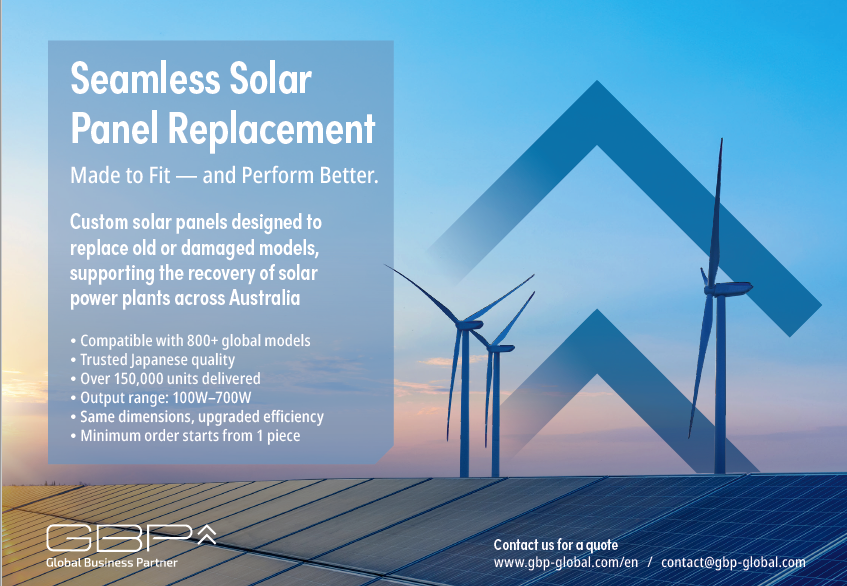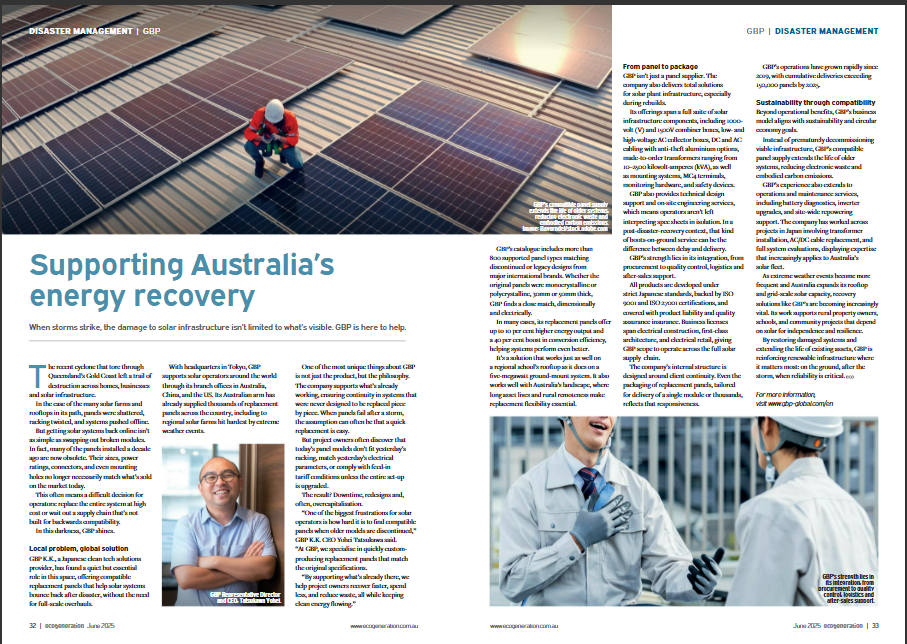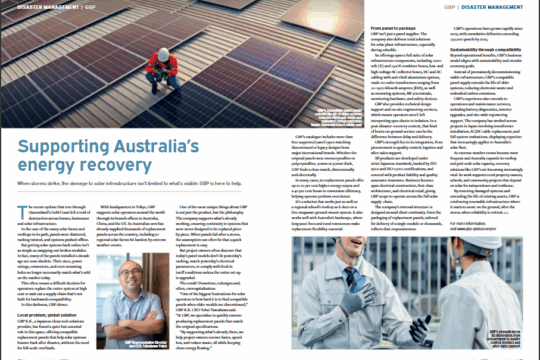01 Made to fit, and perform better
The recent cyclone that tore through Queensland’s Gold Coast left a trail of destruction across homes, businesses and solar infrastructure.
In the case of the many solar farms and rooftops in its path, panels were shattered, racking twisted, and systems pushed offline.
But getting solar systems back online isn’t as simple as swapping out broken modules. In fact, many of the panels installed a decade ago are now obsolete. Their sizes, power ratings, connectors, and even mounting holes no longer necessarily match what’s sold on the market today.
This often means a difficult decision for operators: replace the entire system at high cost or wait out a supply chain that’s not built for backwards compatibility.
In this darkness, GBP shines.
(This article is a reiteration of the content featured in the June–July 2025 issue of Ecogeneration magazine.)

02 Local problem, global solution
GBP K.K., a Japanese clean tech solutions provider, has found a quiet but essential role in this space, offering compatible replacement panels that help solar systems bounce back after disaster, without the need for full-scale overhauls.
With headquarters in Tokyo, GBP supports solar operators around the world through its branch offices in Australia, China, and the US. Its Australian arm has already supplied thousands of replacement panels across the country, including to regional solar farms hit hardest by extreme weather events.
One of the most unique things about GBP is not just the product, but the philosophy. The company supports what’s already working, ensuring continuity in systems that were never designed to be replaced piece by piece.
When panels fail after a storm, the assumption can often be that a quick replacement is easy.
But project owners often discover that today’s panel models don’t fit yesterday’s racking, match yesterday’s electrical parameters, or comply with feed-in tariff conditions unless the entire set-up is upgraded.
The result? Downtime, redesigns and, often, overcapitalisation.
“One of the biggest frustrations for solar operators is how hard it is to find compatible panels when older models are discontinued,” said Yohei Tatsukawa, CEO of GBP K.K. “At GBP, we specialize in quickly custom-producing replacement panels that match the original specifications. By supporting what’s already there, we help project owners recover faster, spend less, and reduce waste — all while keeping clean energy flowing.”
GBP’s catalogue includes more than 800 supported panel types, sourced and stored to matching discontinued or legacy designs from major international brands. Whether the original panels were monocrystalline or polycrystalline, 30mm or 50mm thick, GBP finds a close match – both dimensionally and electrically. In many cases, its replacement panels offer up to 10% higher energy output and a 40% boost in conversion efficiency, helping systems perform even better than before.
It’s a solution that works just as well on a regional school’s rooftop as it does on a five-megawatt (MW) ground-mount system. And it’s one that fits particularly well with Australia’s landscape, where long asset lives and rural remoteness make replacement flexibility essential.

03 From panel to package
GBP isn’t just a panel supplier. The company also delivers total solutions for solar plant infrastructure, especially during rebuilds.
Their offerings span a full suite of solar infrastructure components, including 1000-volt (V) and 1500V combiner boxes, low- and high-voltage AC collector boxes, DC and AC cabling with anti-theft aluminium options, made-to-order transformers ranging from 10–2500 kilovolt-amperes (kVA), as well as mounting systems, MC4 terminals, monitoring hardware, and safety devices.
GBP also provides technical design support and on-site engineering services, which means operators aren’t left interpreting spec sheets in isolation. In a post-disaster-recovery context, that kind of boots-on-ground service can be the difference between delay and delivery.
GBP’s strength lies in its integration, from procurement to quality control, logistics and after-sales support.
All products are developed under strict Japanese standards, backed by ISO 9001 and ISO 27001 certifications, and covered with product liability and quality assurance insurance. Business licenses span electrical construction, first-class architecture, and electrical retail, giving GBP scope to operate across the full solar supply chain.
The company’s internal structure is designed around client continuity. Even the packaging of replacement panels, tailored for delivery of a single module or thousands, reflects that responsiveness.
GBP’s operations have grown rapidly since 2019, with cumulative deliveries exceeding 150,000 panels by 2025.

04 Sustainability through compatibility
Beyond operational benefits, GBP’s business model aligns with sustainability and circular economy goals.
Instead of prematurely decommissioning viable infrastructure, GBP’s compatible panel supply extends the life of older systems, reducing electronic waste and embodied carbon emissions.
GBP’s experience also extends to operations and maintenance services, including battery diagnostics, inverter upgrades, and site-wide repowering support. The company has worked across projects in Japan involving transformer installation, AC/DC cable replacement, and full system evaluations, displaying expertise that increasingly applies to Australia’s solar fleet.
As extreme weather events become more frequent and Australia expands its rooftop and grid-scale solar capacity, recovery solutions like GBP’s are becoming increasingly vital. Its work supports rural property owners, schools, and community projects that depend on solar for independence and resilience.
By restoring damaged systems and extending the life of existing assets, GBP is reinforcing renewable infrastructure where it matters most: on the ground, after the storm, when reliability is critical.

